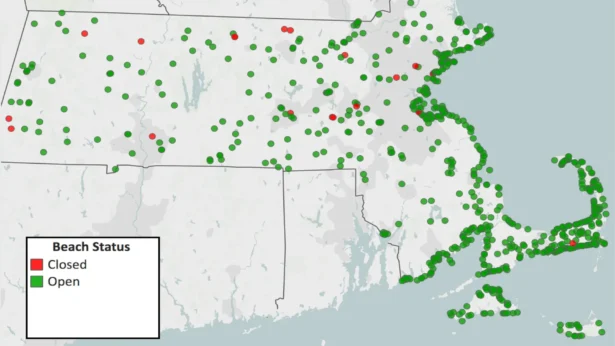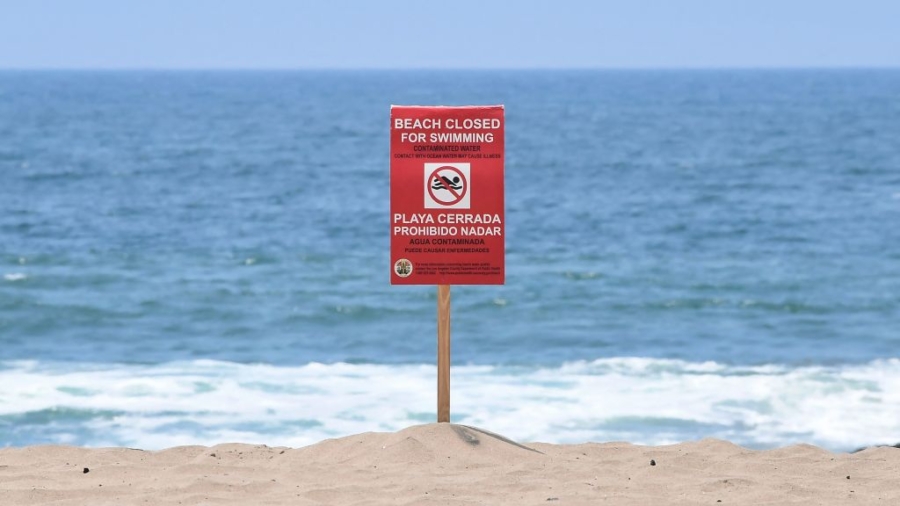Swimmers in Massachusetts will have fewer options to enjoy a day at the beach after more than a dozen locations across the state were closed due to excessive levels of bacteria contaminating the water.
According to a dashboard from the Massachusetts Department of Public Health (DPH) tracking water quality, a total of 20 beaches are currently closed across the Bay State—18 of them because bacteria levels exceed the acceptable limits.
The dashboard, updated twice daily during the beach season, lists “harmful cyanobacteria blooms” and “other” as the reasons for other closures.
Omar Cabrera, a representative for the public health agency, told NTD via email that swimming in unsafe waters can result in health problems with symptoms listed below.
- Gastrointestinal symptoms like nausea, vomiting, diarrhea, and abdominal pain;
- Respiratory symptoms like sore throat, cough, runny nose, and sneezing;
- Dermatological symptoms like skin rash and itching;
- Eye and ear symptoms like irritation, earache, and itching;
- Flu-like symptoms like fever and chills.
While most of those symptoms are minor, more serious illness may occasionally occur, Ms. Cabrera said. People with a weakened immune system, as well as children and the elderly, are at greater risk of getting sick, she added.
“If a beach is closed, do not swim or enter the water at that location to avoid risk of illness,” the DPH warned.
The beaches with bacterial levels exceeding health standards include several locations along the Atlantic Ocean such as Lynn Shore Beach in Lynn and Wollaston Beach in Quincy, according to a map showing all closed locations.
The majority of the beaches are located inland.

The DPH has attributed the closures to heavy rain, explaining that a preceding rainstorm “washes the bacteria or excessive nutrients on land into the water,” allowing small populations of bacteria to “rapidly reproduce to unsafe levels.”
Additional reasons for closures include algae blooms, preventative closure before a rainfall event, marine animals, and other hazards such as stormwater overflow, storm damage, and water clarity or visibility issues.
“The numbers and timing of beach closures can fluctuate dramatically based on rainfall and environmental conditions,” Ms. Cabrera said. “As an example: As of July 10, 2023, there were 53 beach closures. At the same time, in 2022, there were 40 beach closures.”
Here is a list of the beaches that are closed as of June 5 due to excessive levels of bacteria:
- Damon Pond Beach in Ashby
- Hopkinton Reservoir-Main Beach in Ashland
- Hopkinton Reservoir-Upper Beach in Ashland
- Cold River Pool in Charlemont
- Chicopee Beach in Chicopee
- Clipper Lane in Dennis
- Old Maid’s Park in Great Barrington
- Greenfield Municipal Bathing Beach in Greenfield
- Lynn Shore Beach in Lynn
- Wollaston Beach (Channing Street) in Quincy
- Wollaston Beach (Sachem Street) in Quincy
- Pearce Lake (Breakheart Reservation) in Saugus
- Beamans Pond (Campground) in Templeton
- Beamans Pond (Day Use) in Templeton
- Pearl Hill Pond Beach in Townsend
- NVSR: Tiki Pond 1 in Westford
- Shannon Beach (Upper Mystic) in Winchester
- Lake Quinsigamond-Regatta Point Beach in Worcester
In addition, Cochituate State Park Beach in Natick is closed due to “harmful cyanobacteria blooms,” while Lake Mansfield in Great Barrington is shut down for “other” reasons, according to the DPH.

